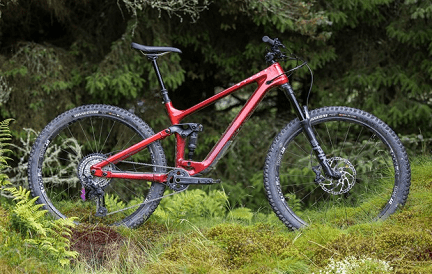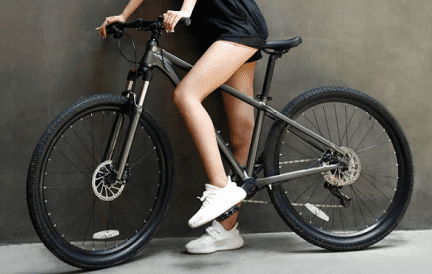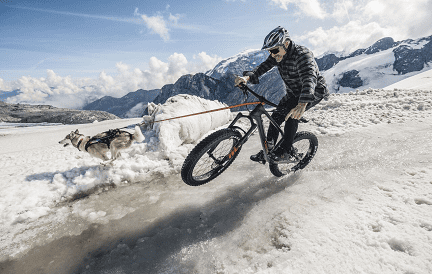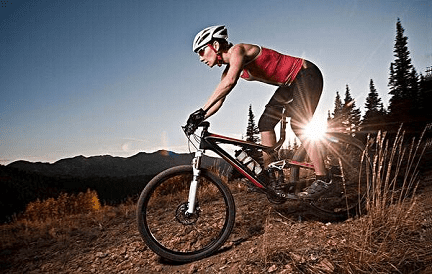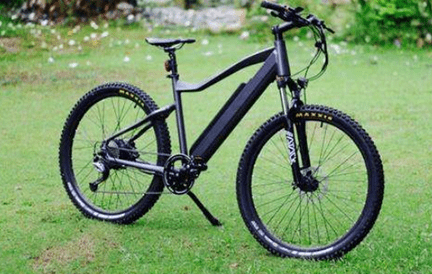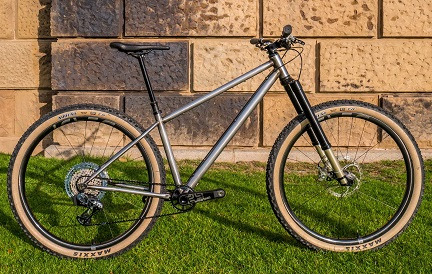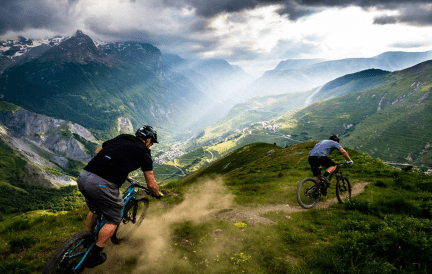The most well-known type of mountain bike is a hardtail. You’ve come to the right place if you’re seeking some great hardtail mountain bikes for sale. Additionally, if you intend to get one, stay here! Cause we have made it clearly obvious to you.
- Part 1: Great Hardtail Mountain Bikes For Sale
- Part 2: Products Specifications
- Part 3: Types Of Mountain Bike
- Part 4: Mountain Bike Buyer’s Guide
- Part 5: Conclusion
Part 1: Great Hardtail Mountain Bikes For Sale
Santa Cruz Chameleon ($2,399)
Firstly, hardtail mtb for sale is Santa Cruz Chameleon. Chameleon is one of the original hardtails that were made. It has also held up well over time. Geometry and the build kit have kept up with today’s riders, so Santa Cruz has kept both of these things up-to-date.
For this Santa Cruz Hard Tail Mountain Bike, you get a Fox 34 Rhythm 120mm fork, a high-end NX Eagle drivetrain, and SRAM’s Guide T brakes. Guide Ts are a great addition in this price range because they give you the four-piston power you need to ride a bike like this.
Santa Cruz made an interesting choice. Specifically, they put a Minion on the front and an Ardent Race on the back, which gives you a sense of how the bike will perform. This hardtail bike is meant to be efficient and fast, and hold on when the going gets rough, so you can keep going (and still super fast).

Pros
- This bike is a very tough but remarkable frame.
- Balanced aggro trail geometry.
- Adjustable dropouts.
- 29 and mullet options.
- Fox Rhythm forks and high-control tyres make this set of wheels stand out.
Cons
- The kit is mostly good but not great
- The fork needs more pressure than it says it does.
- Heavier than you’d like.
Ibis DV9 Deore Hardtail Bike. ($2,775)
Secondly, hardtail bikes for sale is Ibis DV9 Deore. Ibis has been making many waves lately with its AF line, but don’t forget about the DV9. Because, it is still made of Ibis’s well-known carbon, which helps keep the weight down and quiet trail chatter on rougher rides. Also, that carbon makes it race-ready at a much more reasonable price than some racing whips out there, which can be a little pricey.
Furthermore, progressive XC geometry features a slightly slacker head tube and a steeper seat tube than prior generations of cross-country bikes, which works well with the Ibis DV9 Deore Factory. Geometry has advanced significantly. However, this bike stays true to its roots by emphasizing XC.
Lastly, Ibis found the sweet spot to keep the price under $3,000. A 100mm Fox 32 Step-Cast fork is an excellent weight-saving option here (and that Kashima bling). Deore components are gaining a solid reputation for their affordability. Additionally, the dropper provides additional space for movement while you are not on the racetrack.
Pros
- DV9 is an affordable bike.
- The DV9 has a solid carbon frame so that it will last.
- The bike is very light, weighing less than 25 lbs at the most.
- For 7 years, Ibis will cover the bike’s frame if it breaks down.
- There is room in the bike’s frame for a frame bag, making it a good bike for going on long trips by bike.
Cons
- The DV9 is not compatible with plus tires.
- Experts discovered that the bike lacked trust in corners.
Marin San Quentin 1 Hardtrail Bike ($899)
If the Marin San Quentin 1 appears to be similar to a dirt jump bike, that is because it is. Marin blended dirt jump frame components with modern trail geometry to create a capable tough 27.5 hardtail mountain bike.
In this case, it’s the cheapest one. You get a lot for your money, though. In fact, It’s one of the best non-suspension mountain bikes for under $1,000 that doesn’t have much gear. The MicroShift 1×9 drivetrain is one of the best parts of the bike. On the other hand,A great way to save money without giving up a lot of gear range is to use a non-stock transmission.
There is a Suntour fork with 120mm travel, Tektro hydraulic disc brakes with 27.5-inch wide tires, and other parts from Marin. The price is low enough that you can get all of this.In fact, dropper posts are the most obvious thing that this set-up doesn’t have.
Pro
- It has an aggressive shape and wide rims that give the tyres a lot of volume and shape.
Con
- The climbing potential is hampered by the gear’s heavyweight and narrow gear range.
Part 2: Products Spesifications
Santa Cruz Chameleon
Biking Type: Mountain
Used For: XC, Trail
Gearing: 1 x 12
Handlebar Shape: Riser
Frame Material: Aluminum Alloy
Brake Type: Hydraulic Disc
Water Bottle Mounts: 2
Fork: RockShox Recon RL
Stanchion Diameter (mm): 35
Front Travel (mm): 120
Front Travel (in): 4.7
Shifters: SRAM NX Eagle™
Rear Derailleur: SRAM SX Eagle™
Crankset: SRAM SX Eagle™ 148 DUB, 30t
Cassette: SRAM PG-1210, 11-50t
Chain: SRAM SX Eagle™
Bottom Bracket: SRAM DUB 68/73mm
Brake Levers: SRAM Level
Brake Calipers: SRAM Level
Rotors: Avid Centerline 180mm
Headset: Cane Creek 10 IS Integrated
Handlebar: Race Face Ride
Bar Tape/Grips: Santa Cruz Palmdale
Stem: Race Face Ride
Saddle: WTB Silverado Comp
Seatpost: SDG Tellis
Hubs: SRAM MTH 716 Front / SRAM MTH 746 Rear: 15×110 Front / 12×148 Back
Rims: WTB ST i30 TCS 2.0
Spokes: Sapim Race
Front Tyres: Maxxis Minion DHF 3C EXO TR | 29 x 2.3″
Rear Tyres: Maxxis Ardent Race EXO TR | 29 x 2.35″
Warranty: Limited Lifetime (Frame and Bearings Only)
Ibis DV9 Deore Hardtail Bike
Riding Type: Trail, Cross Country
Rider: Unisex
Sizes and Geometry: SM, MD, LG, and XL
Wheel Size: 29″
Frame Material: Carbon Fiber
Frame Material: Details Carbon Fiber Monocoque
Rear Travel: Hardtail
Rear Shock: None
Fork: FOX FLOAT 34 Rhythm, GRIP damper
Fork Travel: 120mm
Head Tube Diameter: Tapered, 1.125″ top, 1.5″ bottom
Headset: Cane Creek 40, ZS44/EC49
Handlebar: Ibis alloy, 780 mm wide, 20 mm rise and 4 x 9 ° bends, and 31.8mm clamp diameter.
Stem: Ibis, 31.8mm bar clamp
Length: 50mm (SM), 60mm (MD/LG), 70mm (XL)
Grips: Lizard Skins Charger Evo
Brakes: Shimano Deore M6100, 2-piston, Shimano RT66 rotors (180mm front, 160mm rear)
Brake Levers: Shimano Deore M6100
Drivetrain: 1x
Shifters: Shimano Deore M6100, 12-speed
Front: Derailleur None
Rear Derailleur: SHADOW RD+, Shimano Deore M6100, 12-speed
Cranks: Shimano Deore M6100, 24mm spindle
Length: 170mm (SM/MD), 175mm (LG/XL)
Chainrings: Shimano Deore M6100, 32 tooth alloy
Bottom Bracket: Shimano SM BB52, 73mm BSA threaded
Chain: Shimano Deore M6100, 12-speed
Cassette: Shimano Deore M6100, 12-speed, 10-51 tooth
Rims: Ibis S35 aluminum
Tyres Front: Schwalbe Hans Dampf, Apex, TLE, 29″ x 2.6″
Rear: Apex, TLE, 29″ x 2.6″
Saddle: WTB Silverado, 142mm width
Seatpost: Ibis aluminum, 350mm length
Seatpost Diameter: 31.6mm
Seatpost Clamp: Single bolt
Rear Dropout: 148x12mm Boost
Max: Tyres Size 29″ x 2.6″
Bottle Cage Mounts: Two inside front triangle
Warranty Frame and rims: 7 years, 1 year paint and finish:
Frame weight: 1204g (size LG)
Marin San Quentin 1
Weight: 14.7kg (L) – without pedals
Available sizes: S, M, L, XL
Headset: FSA
Tyres: Schwalbe Hans Dampf Performance 27.5×2.3in
Stem: Marin 3D-forged, 45mm
Shifter: Shimano Acera M3000
Seatpost: Marin Alloy Light rigid
Saddle: Marin MTB
Rear derailleur: Shimano Altus (1×9)
Handlebar: Marin Mini-Riser, 780mm
Bottom bracket: square-taper
Grips/Tape: Marin MTN
Frame: Double-butted 6061 aluminium alloy
Fork: SR Suntour XCM32, 120mm (4.7in) travel
Cranks: Marin forged alloy, 32t
Chain: KMC X9
Cassette: SunRace, 11-36t
Brakes: Tektro M275, 180mm/160mm rotors
Wheels: Marin, double-walled aluminium
Part 3: Types Of Mountain Bike
Some mountain bikes come in different sizes and styles. Geometry, tire sizes, rigidity, and weight are all different. They also have different suspensions, seat posts, and so on and so forth, too. A lot of them are different, but they are usually broken down into the following groups:
Rigid
These mountain bikes don’t have any suspension on the front fork or the back of them at all. Beginners who choose this bike for off-road or hard-pack dirt will be beaten to a pulp and hate mountain biking before they even get the chance to like it. There’s not much else to say about this other than that. This type of bike is comfortable and versatile for riding on the ground. It is safer and easier to use than a road bike.
Hardtail
A hardtail is a mountain bike that has shocks on the front fork but not the back. There are also some advantages to hardtail bikes that start out. They are easier to ride than full-suspension bikes. Hardtail mountain bikes aren’t just for beginners who want to save money. Their lighter weight and rigidity make them great cross-country bikes and racing bikes.
Downhill
There is much full suspension in these bikes, but they are heavy and have many suspensions in the front and back. Also, Tyres are very big and very bumpy.
All-mountain / Enduro
All-mountain/enduro mountain bikes are more useful going uphill than downhill-specific bikes but are less adaptable than cross-country or trail bikes. They typically feature higher front suspension travel (about 150 mm) and are more robust than XC or Trail bikes with bigger tires.
Trail
These are the most popular mountain bikes because of their reduced weight, mid-travel front forks (120-150 mm), and a geometry that prioritizes comfort above pure performance.
Cross-country
These mountain bikes are designed for lengthy, adventurous rides through the wilderness. When it comes to cross-country bikes, lightweight and smooth, precise shifting are key considerations. Rolling and pedaling efficiency take precedence over the bike’s challenging terrain handling ability.
Fat bikes
Some of these bikes are made for riding on snow and sand or anywhere where you need very wide tires (up to 5 inches wide). In other words, fat bikes are all about being able to ride in all four seasons.
Part 4: Mountain Bike Buyer’s Guide
What Type of Riding Do You Do
Firstly, It’s critical to choose early on the type of trails you intend to travel and the type of terrain you want your bike to succeed. Because it will assist you in determining the type of bike you require, ranging from short-travel, lightweight cross-country machines to durable, chunky downhill race bikes.
What Wheels Size Should You Choose
Then, Except for dirt-jumping and slopestyle bikes, 26-inch mountain bike wheels have been phased out in favor of larger and faster-rolling rims.
Any new adult bike will have wheels measuring 27.5in (also known as 650b) or 29 in diameter. If our local trails indicate, the market has now shifted to an approximately 50/50 split. 29er wheels have the advantage of higher momentum retention, easier rolling over obstacles, and more traction (due to the more extended contact patch of their tyres).
The downsides of larger wheels are that they accelerate more slowly, require more work to slow down, and are more difficult to initiate a turn with. It is not a problem in most situations, but if your riding style is highly dynamic or if you enjoy riding tight, twisting, and steep trails, 650b may be preferred. Although early 29ers exhibited certain handling peculiarities, contemporary geometry ensures that they ride on a par with smaller-wheeled bikes.
However, the added height provided by 29in wheels is worth considering, particularly if you are not particularly tall. In a nutshell, 650b is enjoyable, while 29in is fast – which, of course, can also be enjoyable.
Finally, mullet bikes use different-sized wheels on either end, most frequently a 29in front-wheel for speed and rolling over obstacles and a 27.5in rear-wheel for precise control.
Is There a Difference Between Women’s and Men’s Bikes
On the other hand, almost all major bike manufacturers offer what they refer to as ‘unisex’ bikes; bikes they claim are built for all riders. Numerous brands also produce women’s bikes, frequently referred to as women s-specific bikes. Often, these are similar to unisex bikes, but with distinct contact points, such as the saddle and handlebar, that are intended to be more comfortable for women.
The question then becomes whether women are required to ride a women’s-specific bike; the answer is no, but many women feel that they fit them better. If possible, it’s often worthwhile to try out several unisex and women-specific bikes to determine which one feels the most comfortable for you.
What Size Mountain Bike You Need
Lastly, bicycles were classified according to their seat-tube length. It is still a critical factor, as you need to be able to raise the saddle to an efficient pedaling height and lower it out of the way when descending. The development of long-travel dropper seatposts, on the other hand, has enabled bike designers to shorten seat-tube lengths. Along with increased mobility, this allows riders to ‘upsize’ to a larger frame if they desire additional length.
In fact,perhaps the most critical parameter for determining how large a bike will seem to ride is its reach – the horizontal distance between the bottom bracket’s centre and the top of the head tube’s centre. This measurement accurately predicts how stretched out you will feel while standing on the pedals.
Moreover, it’s frequently advisable to visit your local bike store and test ride the bike you’re considering. If feasible, arrange for a test ride to get a feel for how the bike handles on the path. Numerous brands host demo days during which they bring their whole product line for prospective clients to try.
As a general rule, if you’re looking for a high-end bike, many shops will gladly customize particular components such as the saddle, tyres, or grips to your specifications in order to close the deal. While online or direct sales bike stores do not allow you to try before you buy, the most of them provide a generous return policy if you are unhappy with the fit of your new machine.
Part 5: Conclusion
What Authors have listed for great hardtail for sale, that’s what Author think is best for now—all back again with what kind of hardtail you need and your budget. Additionally, when you buy a mountain bike, there are many things you need to think about. You should do much research before you get one. Finally, if you want to buy a mountain bike, it’s better for you to go directly to the bicycle shop near you.

